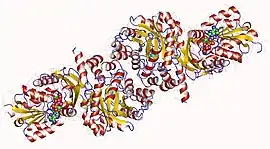4-hydroxy-2-oxovalerate aldolase
The enzyme 4-hydroxy-2-oxovalerate aldolase (EC 4.1.3.39) catalyzes the chemical reaction
- 4-hydroxy-2-oxopentanoate acetaldehyde + pyruvate
| 4-hydroxy-2-oxovalerate aldolase | |||||||||
|---|---|---|---|---|---|---|---|---|---|
 4-Hydroxy-2-oxovalerate aldolase heterotetramer (bifunctional), Pseudomonas | |||||||||
| Identifiers | |||||||||
| EC no. | 4.1.3.39 | ||||||||
| Databases | |||||||||
| IntEnz | IntEnz view | ||||||||
| BRENDA | BRENDA entry | ||||||||
| ExPASy | NiceZyme view | ||||||||
| KEGG | KEGG entry | ||||||||
| MetaCyc | metabolic pathway | ||||||||
| PRIAM | profile | ||||||||
| PDB structures | RCSB PDB PDBe PDBsum | ||||||||
| |||||||||
Baker et al. showed that BphI, a member of this family from Burkholderia xenovorans LB400 was able to utilize 4-hydroxy- 2-oxohexanoate (HOHA) with equal catalytic efficiency as 4-hydroxy-2-oxopentanoate, producing propionaldehyde + pyruvate. Furthermore, the enzyme was also able to catalyze the cleavage of 4-hydroxy-2-oxoheptanoate (HOHEP), forming butyraldehyde + pyruvate. Baker et al. we also able to show that acetaldehyde and propionaldehyde are not released into the bulk solvent, but are channeled to an associated acetaldehyde dehydrogenase known as BphJ. This is the first demonstration of substrate channeling in this family of enzymes.
This enzyme belongs to the family of lyases, specifically the oxo-acid-lyases, which cleave carbon-carbon bonds. The systematic name of this enzyme class is 4-hydroxy-2-oxopentanoate pyruvate-lyase (acetaldehyde-forming). Other names in common use include 4-hydroxy-2-ketovalerate aldolase, HOA, DmpG, BphI, 4-hydroxy-2-oxovalerate pyruvate-lyase, and 4-hydroxy-2-oxopentanoate pyruvate-lyase. This enzyme participates in 8 metabolic pathways: phenylalanine metabolism, benzoate degradation via hydroxylation, biphenyl degradation, toluene and xylene degradation, 1,4-dichlorobenzene degradation, fluorene degradation, carbazole degradation, and styrene degradation.
References
Further reading
- Manjasetty BA, Powlowski J, Vrielink A (June 2003). "Crystal structure of a bifunctional aldolase-dehydrogenase: sequestering a reactive and volatile intermediate". Proceedings of the National Academy of Sciences of the United States of America. 100 (12): 6992–7. Bibcode:2003PNAS..100.6992M. doi:10.1073/pnas.1236794100. PMC 165818. PMID 12764229.
- Powlowski J, Sahlman L, Shingler V (January 1993). "Purification and properties of the physically associated meta-cleavage pathway enzymes 4-hydroxy-2-ketovalerate aldolase and aldehyde dehydrogenase (acylating) from Pseudomonas sp. strain CF600". Journal of Bacteriology. 175 (2): 377–85. doi:10.1128/jb.175.2.377-385.1993. PMC 196151. PMID 8419288.
- Manjasetty BA, Croteau N, Powlowski J, Vrielink A (April 2001). "Crystallization and preliminary X-ray analysis of dmpFG-encoded 4-hydroxy-2-ketovalerate aldolase--aldehyde dehydrogenase (acylating) from Pseudomonas sp. strain CF600" (PDF). Acta Crystallographica D. 57 (Pt 4): 582–5. doi:10.1107/S0907444901000439. PMID 11264589.
- Baker P, Pan D, Carere J, Rossi A, Wang W, Seah SY (July 2009). "Characterization of an aldolase-dehydrogenase complex that exhibits substrate channeling in the polychlorinated biphenyls degradation pathway". Biochemistry. 48 (27): 6551–8. doi:10.1021/bi9006644. PMID 19476337.